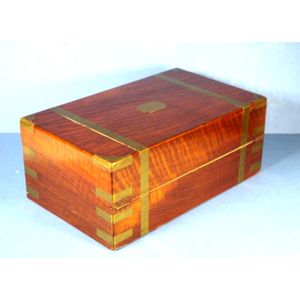Victorian Coromandel Travel Case with Sterling Silver Lids
You must be a subscriber, and be logged in to view price and dealer details.
Subscribe Now to view actual auction price for this item
When you subscribe, you have the option of setting the currency in which to display prices to $Au, $US, $NZ or Stg.
- Victorian Period - The Victorian period of furniture and decorative arts design covers the reign of Queen Victoria from 1837 to 1901. There was not one dominant style of furniture in the Victorian period. Designers used and modified many historical styles such as Gothic, Tudor, Elizabethan, English Rococo, Neoclassical and others, although use of some styles, such as English Rococo and Gothic tended to dominate the furniture manufacture of the period.
The Victorian period was preceded by the Regency and William IV periods, and followed by the Edwardian period, named for Edward VII (1841 ? 1910) who was King of the United Kingdom and the British Dominions and Emperor of India for the brief period from 1901 until his death in 1910. - Sterling Silver - Sterling silver is a mixture of 92.5% pure silver and 7.5% of another metal, usually copper. Fine silver is 99.9% pure silver, and is relatively soft and the addition of the very small amount of copper gives the metal enough strength and hardness to be worked into jewellery, decorative and household objects.
- Calamander / Coromandel - Calamander wood, also known as coromandel wood or coromandel ebony, is a type of hardwood that comes from the Calamander tree (Diospyros quaesita), which is native to Sri Lanka, India, and Southeast Asia. The wood is known for its dark brown or black colour and its distinctive figuring, which can resemble a snakeskin pattern.
The wood is highly prized for its beauty and durability. It is often used in fine furniture making, particularly in the production of inlaid and marquetry work, as well as in the making of boxes, cabinets, and other decorative items. It is also used in the manufacture of flooring, paneling and other architectural applications.
Calamander wood is a very hard and heavy wood, it has a density of around 1.04 g/cm3. Its density and high natural oil content make it resistant to decay and insects, which is why it is a popular choice for outdoor furniture, flooring and other decorative items.
The wood is also used for turning and carving, but is difficult to work due to its high density and interlocking grain. However, it takes a high natural polish and has a beautiful lustre, which is why it is so sought after.
Due to the high demand and over-exploitation of the natural resources, the calamander tree is now a protected species, and the harvesting and export of the wood is heavily regulated.
This item has been included into following indexes:
Visually similar items

A Chinese hardwood presentation box of rectangular form, with brass plaque Orlando Arboreal international. Possibly Huanghuali wood circa 1970. Height 15.8 cm. Width 42.5 cm. Depth 29.2 cm

A 19th century Macassar ebony dressing case by J. Bradshaw & Sons Liverpool, oblong with brass stringing and clashed edges, an inlaid cartouche engraved with a cockerel crest and dated 1871, the interior fitted with silver topped jars and containers engrav

Mid Victorian walnut campaign writing slope box, cedar lined with drawer, ink bottles, pen and nibs, 40 cm x 24 cm, 16.5 cm high (lid closed)

A Georgian burr elm and boxwood stringing tea caddy box, early 19th century interior with two lidded compartments and turned ivory knobs. Height 13.5 cm; width 18 cm; Depth 10.5 cm
